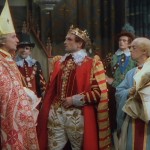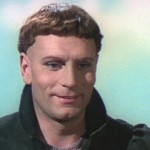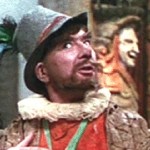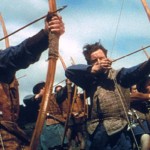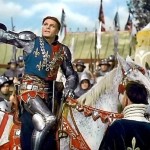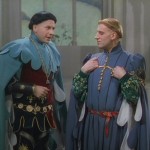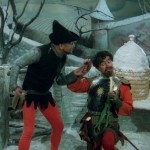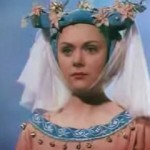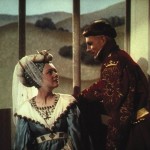
Henry the Fifth – 1946
Hooray for Technicolor! Henry the Fifth was new to me. I’ve never seen any of Shakespeare’s histories, so this was a first. As I didn’t already know the plot, the Shakespearian language was a little difficult to follow at times, but I think I got the gist of it.
The film starred Lawrence Olivier as Henry, Prince of England. The plot tells of his ascension to his kingship and his campaign against France during the Hundred Years War, specifically the Battle of Agincourt. The battle was a fantastic victory for England because they defeated the French Army which was far superior in numbers.
As a result of the victory, Henry married the daughter of the French monarch, King Charles VI, played by Harcourt Williams. His daughter, Princess Katherine, played by Renee Asherson, strangely enough, was the only woman in France who spoke French, but only because it was a plot point that there be a language barrier between her and King Henry.
And that’s it. That’s the basics of the plot. There were a few sub-plots, a few comedic characters, and a few bad-guys who got their just deserts, but these characters were mostly superfluous. They didn’t really need to be there. I’m not sure if this is the fault of Olivier’s script, or Shakespeare’s original play, but I suspect the latter.
I’ll explain: The comic relief was mostly in a character called Ancient Pistol, played by Robert Newton. He was a drunken coward who was constantly, yet unsuccessfully, trying to find ways to escape the various battles. He really had nothing to do with the plot, and offered no commentary or unique perspective on anything. The bad guys violate “the law of arms” by riding behind Henry’s lines and slaughtering all the young squires in Henry’s camp. In retribution and anger, Henry fights and kills the French Constable, played by Leo Genn, the only villain shown doing any fighting on the battlefield.
And while I am focusing on the negative aspects of the film, I have to mention the fact that most of the actors only knew how to deliver their Shakespearian dialogue by shouting. There was no subtlety to anyone’s performance and it got old pretty quickly. Sure, much of Olivier’s dialogue needed to be shouted because he was often addressing his court or his troops. But when the English Earls and Dukes are just conversing with each other, there seemed to be little cause for all the shouting, aside from the actor’s desire to sound impressive. It is possible that this might have been the result of stage actors doing film work, but I am only guessing on that point.
What really made the film interesting to me was its structure, and its costumes. The structure was a little disjointed, but it kept me on my toes. The first scene took place in Henry’s court. This was filmed as if it were an actual stage production. Olivier even showed shots of the actors putting on makeup and costumes back-stage, and shots of the audience as they watched the performance. But once Henry took left for France, the “play” ended and the army of extras were filmed marching through actual fields. Then, in the end, when Henry and Katherine are wed, we find ourselves back in the playhouse.
I actually hated the costumes… at first. They looked like stage costumes, which worked for the scenes that took place in the “play”, but once the transition was made to a more realistic setting, I would have liked to see more realistic costumes. However, I learned that Olivier was basing the costumes on period specific illustrations that were created in Shakespeare’s time. There were lots of bright colors and no dirt – not realistic, but an artist’s rendering. In light of that, the silly looking costumes made a certain amount of sense, though every man in those illustrations must have been drawn wearing tights.
There was also a certain scene that I have to mention because it stood out to me as well-written and well-acted. Before the battle of Agincourt, Henry disguises himself as a common soldier and walks among his men. He finds that the men are questioning why they fight for a king they have never met, whose cause is not necessarily their own. Henry tries to defend himself without giving away his identity. It was a cleverly written little exchange.
I also learned that Olivier intentionally left out some of Henry’s darker aspects like his threat to unleash his troops to rape and pillage Harfleur, or his ruthless beheading of several traitors to the crown, including one of his own friends. But I guess the omissions are understandable in light of the fact that Winston Churchill asked Olivier to make the film as a propaganda film that would coincide with the invasion of Normandy. After all, we can’t have our hero doing anything that might appear evil or tyrannical, can we?
